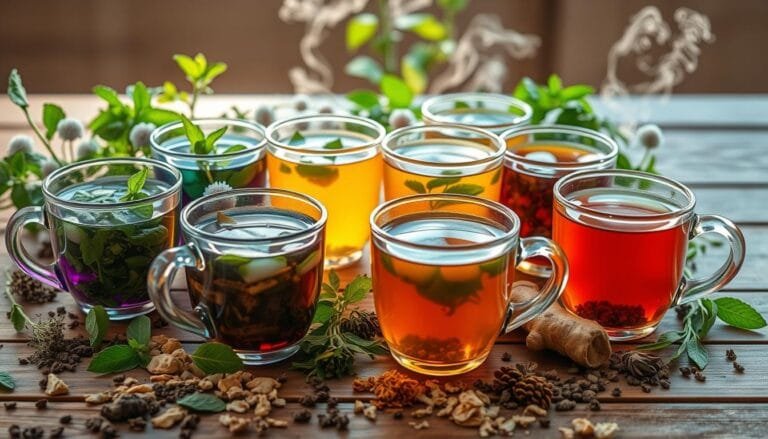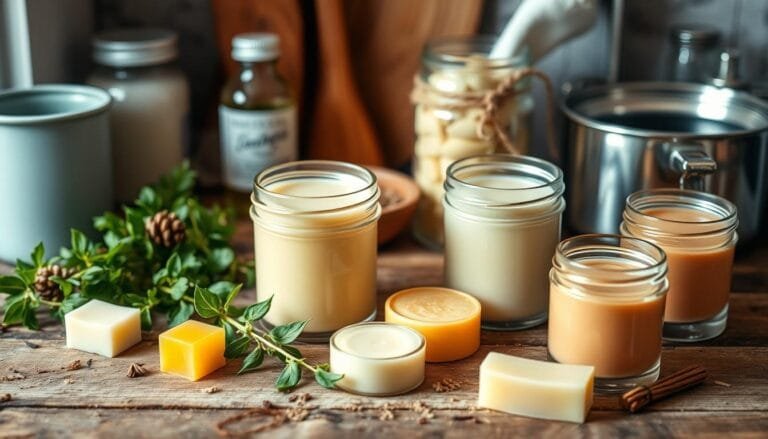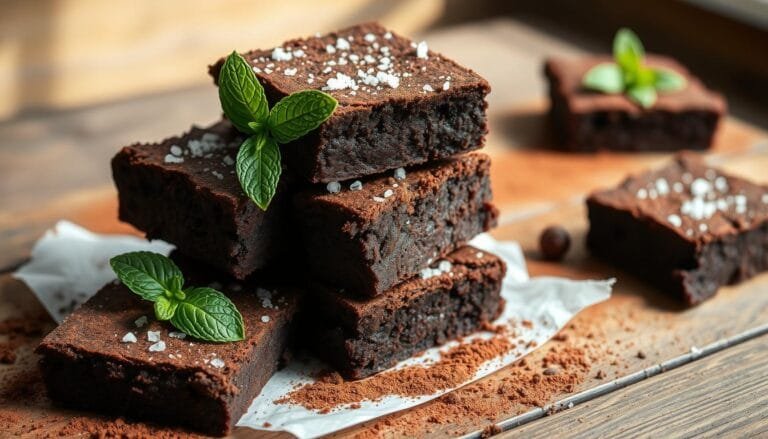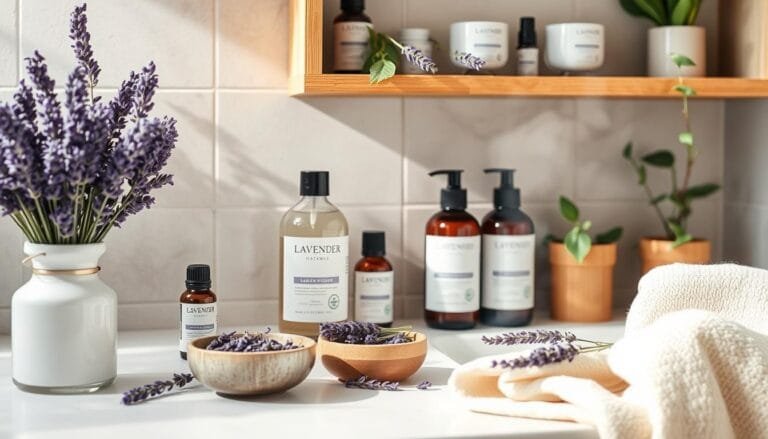I’ve found that homemade herbal bath soaks are amazing for natural self-care. They mix salts, herbs, and essential oils for a calming bath. These soaks help me relax, ease pain, and enjoy some me-time.
Water therapy, or balneotherapy, has been used for ages. Ancient cultures like the Romans and Japanese used baths for health. Adding herbs and oils to my baths makes them even more relaxing and restorative.
Understanding the Power of Herbal Bath Soaks
Herbal bath soaks have been used for centuries to heal and relax. They mix water’s healing power with herbs and minerals. This creates a soothing experience that supports our wellness through hydrotherapy and aromatherapy.
Historical Uses and Benefits
Water’s healing power has been known for ages. The Romans used natural springs for health. In India, Ayurvedic healers used water to keep healthy and improve blood flow.
Water is sacred in many cultures. It cleanses the body and spirit. From the Ganges River to Druid rituals, water is highly valued.
How Bath Soaks Support Wellness
Herbal bath soaks help with stress, muscle pain, skin issues, and mood. Warm water opens pores and relaxes muscles. This lets the herbs’ benefits soak in better.
Water is great at pulling out herbs’ good stuff. This makes it easy for our bodies to use these benefits.
Science Behind Water-Based Herbal Treatments
Studies show hydrotherapy and aromatherapy are good for us. Warm water and herbs can greatly improve our health and mood. The heat and herbs’ scents can ease muscle tension and boost our mood.
“Ritual baths have been integral to various cultures for centuries, indicating a long-standing tradition of incorporating herbs and water for health and wellness.”
Essential Ingredients for Homemade Herbal Bath Soaks
Creating luxurious bath soaks at home is all about natural ingredients. These ingredients have been used for centuries and are backed by science. They make your bath soak recipes truly effective.
The base of any good bath soak is quality salts. Epsom salt, Dead Sea salt, and Himalayan pink salt each bring their own benefits. They relax muscles and nourish the skin, making your bath a true treat.
Dried herbs add a special touch to your bath soak. Lavender, chamomile, and rosemary calm and soothe. Calendula and red clover help your skin stay healthy.
Essential oils and clays are also key. They can be mixed to meet your wellness needs. Whether you want to relax or detox, they’ve got you covered.
Baking soda is a surprising but great addition. It soothes skin, balances pH, and adds a luxurious foam to your bath.
Knowing how these ingredients work lets you make bath soaks that are just right for you. It’s time to take your self-care to the next level with nature’s best.
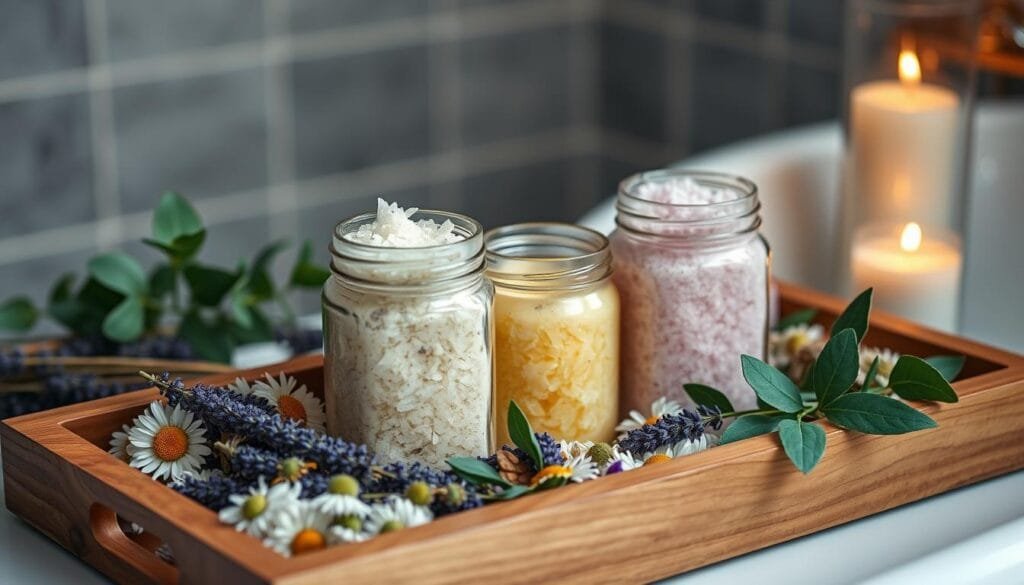
Different Types of Therapeutic Salts and Their Properties
Adding the right mineral-rich salts to your bath can bring many benefits. They can ease muscle tension and improve skin health. Each salt has its own special properties to enhance your self-care.
Epsom Salt Benefits
Epsom salt, or magnesium sulfate, is often used in bath soaks. It’s known for relaxing muscles, reducing inflammation, and helping with detox. The magnesium in Epsom salt is absorbed through the skin, easing muscle pain.
Dead Sea Salt Properties
Dead Sea salt comes from the Dead Sea’s mineral-rich waters. It’s packed with minerals like magnesium, calcium, and potassium. This salt is great for exfoliating, moisturizing, and detoxifying, making skin look healthy and glow.
Himalayan Pink Salt Uses
Himalayan pink salt is mined from the Himalayas. It’s full of minerals like potassium, iron, and calcium. In bath soaks, it helps balance pH levels, aids in detox, and offers a soothing experience.
Each therapeutic salt has its own benefits for your wellness. Try mixing them in your bath soak recipes for a personalized self-care experience.
Beneficial Herbs for Bath Soaks
Medicinal herbs are powerful in making bath soaks soothing and therapeutic. They have been used for centuries to relax, heal skin, and boost well-being. By using different herbal infusions, we can make bath soaks that are truly personalized.
Lavender calms, chamomile soothes skin, and eucalyptus helps with breathing. Rosemary eases muscle pain, comfrey heals skin, and yarrow fights colds. Calendula treats skin issues, and peppermint invigorates. Each herb adds unique benefits to our bath soak recipes.
Herbs can be added to bath soaks in many ways. You can put dried herbs directly in the water, brew them into tea, or use herbal bath tea bags. This flexibility lets us tailor our bath experiences to meet our needs.
| Herb | Benefits |
|---|---|
| Lavender | Calming, relaxing, anti-inflammatory |
| Chamomile | Skin-soothing, anti-inflammatory, healing |
| Eucalyptus | Respiratory relief, decongestant, antimicrobial |
| Rosemary | Muscle pain relief, circulation boost, relaxation |
| Comfrey | Skin healing, anti-inflammatory, tissue repair |
| Yarrow | Cold and flu symptom relief, anti-inflammatory |
| Calendula | Skin-nourishing, anti-inflammatory, wound healing |
| Peppermint | Invigorating, pain-relieving, decongestant |
It’s key to know the safety and interactions of these herbs before using them in bath soaks. With some research and trial, you can make bath soaks that meet your wellness needs.
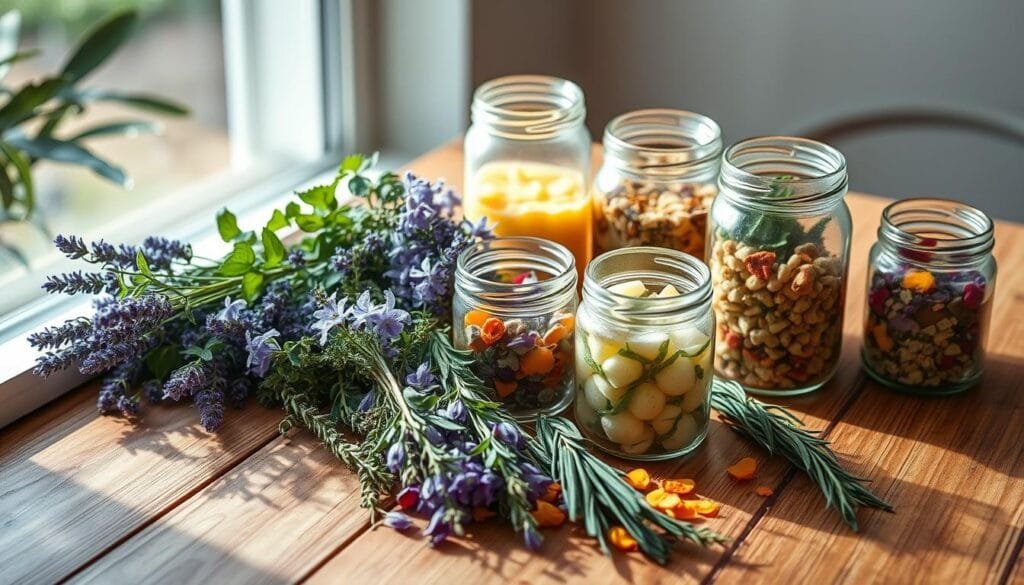
“Herbs can be used in three ways for herbal baths: directly in the bathwater, brewed as a tea added to the bath, or using commercial herbal bath tea bags.”
Essential Oils: Enhancing Your Bath Experience
Aromatherapy is known for changing our moods and helping us relax. Essential oils can greatly improve your bath experience. They add natural fragrances and help improve your mood.
Best Essential Oil Combinations
Some essential oil blends are perfect for bath soaks. They work together to calm and uplift. Try lavender and chamomile for a relaxing soak. Or, mix eucalyptus and rosemary for a refreshing bath.
Citrus oils like bergamot and orange can also boost your mood and energy.
Safety Guidelines for Essential Oil Use
Even though essential oils are natural, they need to be used carefully. Always mix them with a carrier oil or bath soak base. This prevents skin irritation.
Do a patch test before using them. Avoid using oils like tea tree or clove on sensitive skin. Keep essential oils away from children and pets.
Therapeutic Properties
- Lavender: Calms the mind and promotes relaxation.
- Peppermint: Invigorates the senses and can provide a cooling sensation.
- Eucalyptus: Supports respiratory health and can help clear the mind.
- Frankincense: Renowned for its grounding, meditative properties.
- Ylang-Ylang: Helps balance emotions and can induce a sense of tranquility.
Adding the right essential oils to your bath soaks can open up a world of benefits. Try different blends to find what works best for you. This will take your self-care to a new level of relaxation and rejuvenation.
Basic Recipe for Homemade Bath Salts
Making your own bath products at home can be very relaxing. One easy thing to make is bath salts. With just a few ingredients, you can make your own bath salts at home.
The basic recipe for homemade bath salts includes:
- 1 cup Epsom salt
- 1/2 cup Himalayan or Dead Sea salt
- 1/4 cup baking soda
- 1/4 cup dried herbs (such as lavender, rosemary, or chamomile)
- 10-20 drops of essential oils (like lavender, bergamot, or cedarwood)
Mix all the ingredients together in a bowl until well combined. Then, put the bath salts in an airtight container. Use 2-4 tablespoons for each bath. You can change the herbs and essential oils to make your own natural bath recipes and homemade spa treatments.
| Scent Blend | Essential Oil Quantities | Optional Additions |
|---|---|---|
| Sleepy Time | 10 drops lavender, 8 drops sweet orange, 5 drops patchouli | 2 tbsp dried chamomile, 1 tbsp jojoba oil |
| Skin Food | 12 drops geranium, 10 drops ylang ylang, 8 drops frankincense | 2 tbsp French green clay, 1 tbsp powdered milk |
| Relaxing | 10 drops cedarwood, 8 drops sweet orange, 5 drops lavender, 5 drops peppermint | 2 tbsp jojoba oil, 1 tbsp dried lavender |
| Uplifting | 12 drops grapefruit, 10 drops scotch pine, 5 drops bergamot | 1/4 cup French green clay, 1 tbsp dried elderflowers, 1 tbsp dried helichrysum |
With a little creativity and these simple ingredients, you can make your own DIY bath products and natural bath recipes. Enjoy a spa-like experience in your own home.
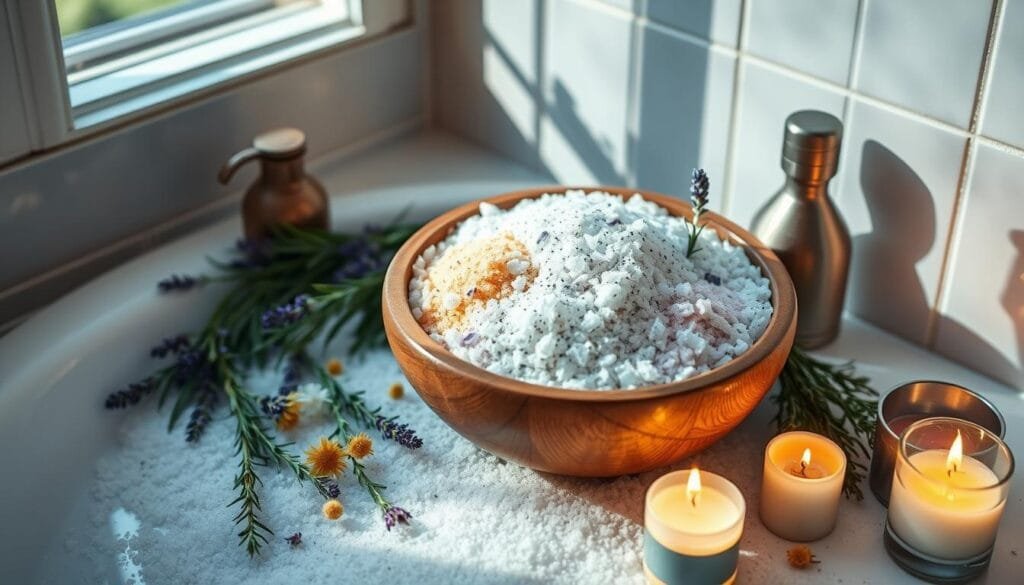
Creating Custom Herbal Bath Tea Blends
Discover the joy of making your own herbal bath tea blends. They can turn your bath into a relaxing escape or a refreshing energizer. The right mix of herbs can change your bath time into a special treat.
Relaxation Blend Options
For a calming bath, try lavender, chamomile, and oatstraw. These herbs help you relax deeply and ease tension. They make your home feel like a spa.
Energizing Combinations
For a boost, mix peppermint, rosemary, and lemon balm. This blend wakes up your senses and lifts your mood. It’s perfect for when you need to feel refreshed.
Skin-Soothing Mixtures
For soft skin, blend calendula, comfrey, and rose petals. This mix calms skin issues, heals, and makes your skin glow. It’s great for skin care.
To make your own blends, put herbs in muslin or cotton bags. Steep them in hot water and add to your bath. These natural ingredients bring healing to your bath time.
| Herbal Bath Tea Blend | Key Ingredients | Therapeutic Benefits |
|---|---|---|
| Relaxation Blend | Lavender, Chamomile, Oatstraw | Promotes deep relaxation, eases tension, and supports restful sleep. |
| Energizing Blend | Peppermint, Rosemary, Lemon Balm | Invigorates the senses, boosts mood, and provides a refreshing pick-me-up. |
| Skin-Soothing Blend | Calendula, Comfrey, Rose Petals | Calms irritation, promotes healing, and leaves skin feeling soft and radiant. |
Try out different herbal tea baths, custom bath blends, and therapeutic herb combinations. Make your bath time special and enjoy the natural benefits. Take your self-care to the next level.
Tools and Equipment Needed
To make your own herbal bath soaks, you need a few basic tools. These items help you measure, mix, and store your bath creations easily.
- Measuring cups and spoons for precise ingredient measurements
- Mixing bowls or jars for blending your bath soak recipes
- Muslin bags or small mesh strainers for containing loose herbs
- A small whisk or spoon for thoroughly mixing your bath soak ingredients
- Storage containers like mason jars to store your finished bath soaks
- Labels or tags to identify your homemade bath creations
For more advanced herbal preparation, some extra tools can be useful:
- A coffee grinder or mortar and pestle to finely grind dried herbs and flowers
- A digital kitchen scale for precise measurement of ingredients like essential oils
With these bath accessories, DIY tools, and herbal preparation equipment, you can make luxurious homemade herbal bath soaks at home.
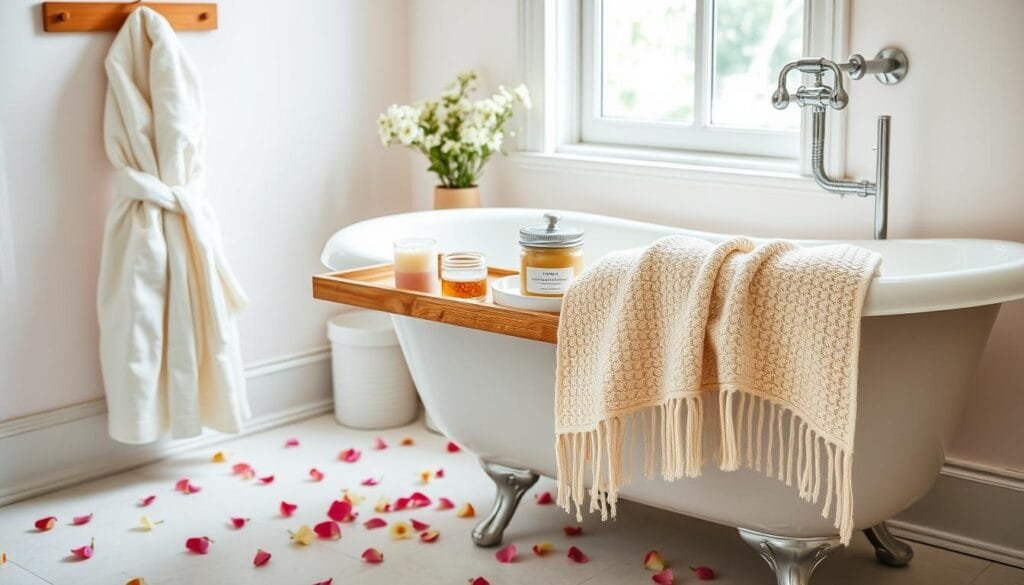
“Having the right tools on hand makes the process of creating homemade bath products so much easier and more enjoyable.”
Start simple and add more tools as you get better at making DIY bath soaks. This way, you’ll grow your collection of bath accessories, DIY tools, and herbal preparation equipment.
Storage and Shelf Life Tips
Keeping your homemade herbal bath products fresh is key. They should be stored away from moisture, sunlight, and contaminants. This helps them stay effective.
For bath salts, use airtight glass jars or sealed plastic containers. This keeps the essential oils and herbs fresh. Your bath salts can last up to 6 months this way.
Herbal blends without salt have a shorter shelf life, about 3-4 months. Adding a few drops of vitamin E oil can help. It acts as a natural preservative, protecting the ingredients.
Always check your bath products before use. Look for mold, discoloration, or changes in scent. If you see any spoilage, throw it away and make a new batch. Keeping them stored properly is essential for their quality and safety.
| Product | Shelf Life | Storage Tips |
|---|---|---|
| Bath Salts with Essential Oils | Up to 6 months | Airtight glass or plastic containers, away from light and moisture |
| Herbal Bath Blends (without salts) | 3-4 months | Airtight containers, add a few drops of vitamin E oil to extend shelf life |
By following these tips, your homemade herbal bath products will last longer. They’ll stay potent and safe. Enjoy your self-care routine with these long-lasting, quality bath soaks.
Alternative Uses for Bath Soaks
Homemade bath soaks are more than just for relaxing in the tub. They can be used in many ways to enhance your self-care. Discover how these bath soaks can be used for different soothing and aromatic experiences.
Foot Soaks
Tired feet need extra care. Turn your bath soaks into a foot soak by adding about 1/2 cup to warm water. The herbs and salts will make your feet feel better and look smoother.
Compress Applications
Use your bath soaks as a compress for sore muscles or skin. Mix a handful of the salts with warm water, soak a cloth, and apply it. It’s a soothing and healing treatment.
Shower Steamers
Use your bath soaks in the shower too. Mix the fragrant ingredients, shape them, and let them dry. Place them in your shower for a spa-like experience as the steam releases the scents.
See how versatile your homemade bath soaks can be. Get creative and find new ways to use them in your self-care routines.
Seasonal Bath Soak Recipes
As the seasons change, our bodies and minds need different wellness support. Making homemade herbal bath soaks for each season is a great self-care practice. Let’s look at some seasonal bath soak recipes that use nature’s power to keep you feeling great all year.
Winter Warming Bath Blend
A warm winter bath blend can soothe your soul when it’s cold outside. Use spicy herbs like ginger and cinnamon to help blood flow and relax muscles. Grounding scents like cedarwood and vanilla can also calm you down in winter.
Spring Floral Bath Tea
In spring, a fragrant floral bath soak can brighten your mood. Mix rose petals, jasmine flowers, and chamomile for a soak that’s both relaxing and refreshing. The soft scents will make you feel like you’re in a blooming garden.
Summer Cooling Herbal Blend
When it’s hot in summer, cool herbs like peppermint and lemon balm are your best friends. They help you stay calm and balanced when it’s warm outside.
Autumn Grounding Bath Salt
In autumn, a bath soak can help you feel grounded and connected. Use earthy elements like cedarwood, vetiver, and clove to feel more rooted and in tune with nature.
Making seasonal bath soaks is a great way to support your seasonal wellness and enjoy aromatherapy for different seasons. Try out different holiday bath blends to find the perfect natural recipe for you.
Gift-Giving Ideas and Packaging Tips
Homemade herbal bath soaks are great natural beauty presents. They show you care. Package them in decorative glass jars or eco-friendly containers for a nice touch.
Adding custom labels with the ingredients and how to use them makes the gift special. It shows you put thought into it.
Make your gifts even better by creating sets. You can mix different herbal bath soaks with body scrubs or lotion bars. Seasonal themes or special blends for the person make your gifts unique.
Use natural materials like raffia or twine for wrapping. This keeps the eco-friendly look.
These homemade herbal bath soaks are perfect for any occasion. With a bit of creativity, you can make them memorable gifts. Your family and friends will love them.

